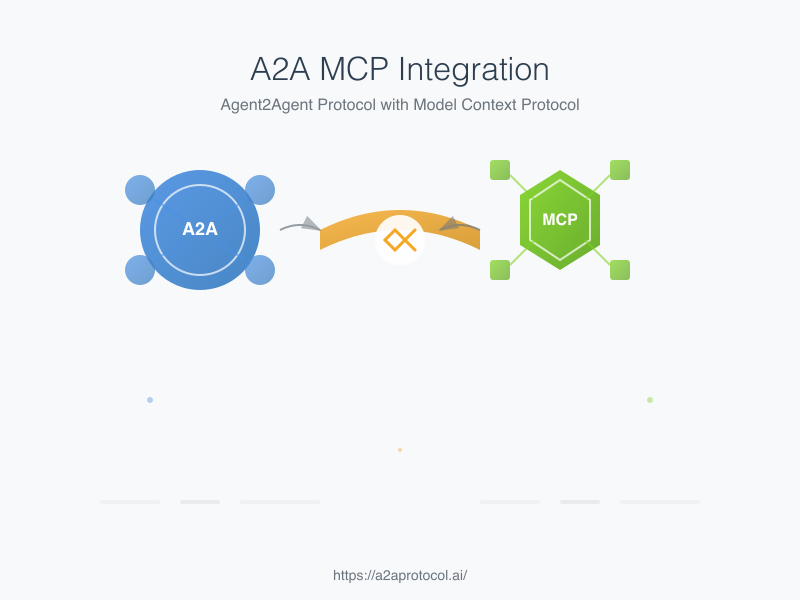
Git Repo:A2A MCP
This repository demonstrates how to set up and use the a2a-python SDK to create a simple server and client implement a2a protocol, and the agent sever is implemented by mcp.
Overview
- A2A (Agent2Agent): A protocol and SDK for building interoperable AI agents.
- This Example: Shows how to run a basic A2A server and client, exchange messages, and view the response.
Prerequisites
- Python 3.13+
- uv (for fast dependency management and running)
- An API key for OpenRouter (set as
OPENROUTER_API_KEY)
Installation
-
Clone the repository:
git clone https://github.com/sing1ee/a2a-mcp-openrouter cd https://github.com/sing1ee/a2a-mcp-openrouter -
Install dependencies:
uv venv source .venv/bin/activate -
Set environment variables:
export OPENROUTER_API_KEY=your-openrouter-api-keyOr create a
.envfile with:OPENROUTER_API_KEY=your-openrouter-api-keyNote: You can get your OpenRouter API key from https://openrouter.ai/
Running the Example
1. Start the Server
uv run --env-file .env a2a-server
- The server will start on port 9999.
validate the agent card:
2. Run the Client
In a new terminal:
uv venv
source .venv/bin/activate
uv run --env-file .env a2a-client --question "What is A2A protocol?"
- The client will connect to the server and send a request.
3. View the Response
- The response from the client will be saved to response.xml.
Configuration
The system uses the following configuration:
- Model:
google/gemini-flash-1.5via OpenRouter - Base URL:
https://openrouter.ai/api/v1
File Structure
src/a2a_mcp_openrouter/server/: Server implementation.src/a2a_mcp_openrouter/client/: Client implementation.response.xml: Example response from the client.
Troubleshooting
- Missing dependencies: Make sure you have
uvinstalled. - API key errors: Ensure
OPENROUTER_API_KEYis set correctly. - Port conflicts: Make sure port 9999 is free.
A2A vs MCP: Protocol Similarities and Unified Approach
Through this implementation, we discovered that A2A (Agent2Agent) and MCP (Model Context Protocol) share remarkable architectural similarities. Both protocols follow a similar pattern for discovery, capability exchange, and execution.
Unified Implementation Pattern
Key Discovery: Both A2A and MCP follow the same underlying implementation pattern:
- HTTP-based Communication: Both use HTTP for communication (A2A uses REST APIs, MCP uses Server-Sent Events)
- Prompt-driven Design: Both rely on LLM prompts to decide what to call and how to call it
- Discovery Mechanism: Both provide ways to discover available capabilities
- Structured Responses: Both return structured data that can be processed programmatically
Looking at the mcp.py implementation, we can see:
# MCP tool discovery via HTTP
async with sse_client(url) as (read, write):
resources = await session.list_tools()
# Generate prompt for LLM decision making
return template.render(tools=resources.tools)
# Execute tool call via HTTP
return await session.call_tool(tool_name, arguments=arguments)
This is conceptually identical to A2A agent calling pattern - discover capabilities, use LLM to decide what to call, then execute the call.
A2A as Universal Interface
Key Insight: A2A can serve as a unified interface for both Agent2Agent communication and tool invocation, because the calling patterns are essentially the same:
- A2A → Agent:
Client → HTTP → Agent → LLM Response - A2A → Tool:
Client → HTTP → Tool Wrapper → MCP Tool Response
Both patterns use:
- HTTP communication
- Capability discovery
- LLM-driven decision making
- Structured request/response format
Benefits of This Unified Approach
- Single Interface: Clients only need to understand one calling pattern
- Interoperability: Mix agents and tools seamlessly in the same workflow
- Consistent Architecture: Same implementation pattern across different capability types
- LLM-native Design: Both leverage LLM reasoning for intelligent capability selection
This demonstrates that A2A and MCP are not competing protocols but complementary patterns that can be unified under a single interface paradigm.
System Architecture and Flow
Below is a detailed sequence diagram showing the complete flow of the A2A protocol from client input to final response:
sequenceDiagram
participant User
participant Client as A2A Client
participant LLM_Client as OpenRouter LLM (Client)
participant Server as A2A Server
participant AgentExecutor as Agent Executor
participant Agent as Server Agent
participant LLM_Server as OpenRouter LLM (Server)
participant MCP as MCP Tool
User->>Client: Input question: "What is A2A protocol?"
Note over Client: Initialize Agent with agent_urls
Client->>Server: GET /agent-card - Discover available agents
Server-->>Client: Return AgentCard with capabilities
Note over Client: Render agent prompt template
Client->>LLM_Client: Send decision prompt with question and available agents
LLM_Client-->>Client: Return JSON with selected agents
loop For each selected agent
Client->>Server: POST /send-message-streaming
Server->>AgentExecutor: execute(context, event_queue)
AgentExecutor->>Agent: stream(query)
Agent->>MCP: Get available tools
MCP-->>Agent: Return tool definitions
Note over Agent: Render tool prompt template
Agent->>LLM_Server: Send decision prompt with question and tools
LLM_Server-->>Agent: Return JSON with selected tools
loop For each selected tool (max iterations)
Agent->>MCP: Call tool with arguments
MCP-->>Agent: Return tool result
Note over Agent: Update called_tools history
Agent->>LLM_Server: Send updated prompt with tool results
LLM_Server-->>Agent: Return next tools or final answer
alt More tools needed
Note over Agent: Continue to next iteration
else Task complete
Note over Agent: Task completed
end
end
Agent-->>AgentExecutor: Yield streaming events
AgentExecutor-->>Server: Forward events to event_queue
Server-->>Client: Stream response chunks via HTTP
Client->>Client: Extract answer from response tags
Note over Client: Add to agent_answers list
end
alt Need final synthesis
Client->>LLM_Client: Send synthesis prompt with all answers
LLM_Client-->>Client: Return final synthesized answer
else No synthesis needed
Note over Client: Use existing answers
end
Client-->>User: Stream final response with agent outputs
Key Features
- Agent Discovery: Automatic discovery of available agents via A2A protocol
- LLM-Driven Selection: Intelligent agent and tool selection using LLM reasoning
- MCP Integration: Seamless integration with MCP tools for knowledge retrieval
- Streaming Pipeline: Real-time streaming responses throughout the entire pipeline
- Iterative Processing: Multi-iteration tool calling with maintained context
Flow Description
The system follows these main phases:
Client Phase: User inputs question → Client discovers agents → LLM selects relevant agents
Server Phase: Server receives request → Agent discovers tools → LLM selects tools → Tools execute iteratively
Response Phase: Results stream back through the pipeline → Client synthesizes final answer → User receives response
This architecture demonstrates the power of the A2A protocol in creating interoperable AI agents that can discover each other and collaborate, while leveraging MCP tools for accessing external knowledge sources.